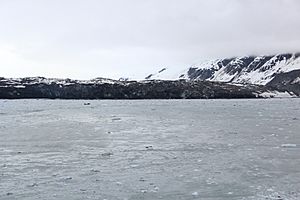Grand Pacific Glacier facts for kids
The Grand Pacific Glacier is a very long glacier that stretches across parts of British Columbia in Canada and Alaska in the United States. It is about 25 miles (40 kilometers) long! This giant ice river starts in Glacier Bay National Park within the Saint Elias Mountains. From there, it flows east into an area called Grand Pacific Pass in British Columbia. Then, it turns southeast and reaches the top of Tarr Inlet, right at the border between Alaska and Canada.
Contents
Understanding the Grand Pacific Glacier
The Grand Pacific Glacier is a massive body of ice. In 2004, it was about 2 miles (3.2 kilometers) wide at its end, which is called the terminus. The ice face, where it meets the air, was often about 150 feet (45 meters) high. Where the glacier met the water, it could be up to 60 feet (18 meters) deep. Overall, the glacier was more than 35 miles (56 kilometers) long!
How Glaciers Move and Change
Glaciers are not still; they slowly flow like very thick rivers. The Grand Pacific Glacier moves at different speeds in different places. The western part of the glacier, which gets ice from another glacier called Ferris Glacier, used to move quite fast. It could flow about 1,500 feet (457 meters) per year, or about 4 feet (1.2 meters) every day! However, the eastern part moved much slower, only about 150 to 180 feet (45 to 55 meters) per year.
The Glacier's Retreat
For many years, the Grand Pacific Glacier had been slowly moving forward. But around 1992, it reached its farthest point when it met another glacier called Margerie Glacier. By 2004, these two glaciers were no longer connected because the Grand Pacific Glacier had started to shrink back. A small stream even flowed between them!
The eastern edge of the glacier was pulling back about 30 to 60 feet (9 to 18 meters) each year. The ice was also getting thinner, and cracks in the ice were closing up. Around 1996, a large curve, like a bay, started to form in the middle of the glacier's end. This part of the ice cliff began to break off into the water more quickly.
Scientists expected this retreat to speed up as the curved area got bigger and the water beneath the glacier got deeper. The glacier would likely keep retreating until it reached a spot where it would be resting on land, not floating in water.
Rock and Debris on the Glacier
A lot of rock and dirt from landslides covers parts of the Grand Pacific Glacier. This debris can be found on the western side and spreads across almost two-thirds of the ice face. When this rock layer is thicker than an inch, it acts like a blanket. It insulates the ice, which means it slows down how fast the ice melts. This causes the ice under the debris to be thicker than areas where the ice is clean. In many places, this rock and dirt layer is more than 3 feet (1 meter) thick!


